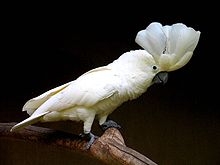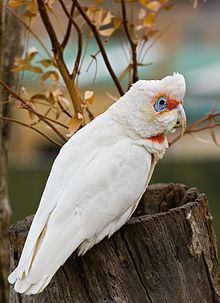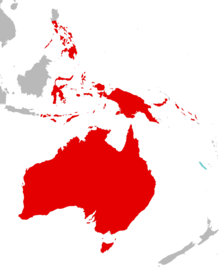Cockatoo
![]()
Kakadu is a redirect to this article. For other meanings, see Cockatoo (disambiguation).
The cockatoos (Cacatuidae) are a well-defined and easily recognizable family of birds in the order of parrots (Psittaciformes). The most striking feature of the cockatoos is the feather hood, which is either flat or widely ruffled depending on the state of excitement. The palm cockatoo, for example, has a very long feather hood. In other species, such as the Raven Cockatoos, it is much smaller. Cockatoos are on average larger than the other species classified as parrots. The plumage of cockatoos is basically less colorful than that of other parrots. Most cockatoo species have a white, gray or black ground coloration. Like all parrots, cockatoos have very strong beaks. The beak morphology often shows adaptations to the preferred food.
Cockatoos can be found in very different habitats. These include the tropical rainforests of the Pacific region as well as cultural areas of the temperate climate zones in the Australian Victoria or Tasmania. Cockatoos eat mainly seeds, roots, fruits, flowers, flower buds and insects. In particular, the species that find most of their food on the ground gather in flocks while foraging. In some species, this can result in aggregations of several hundred birds. Cockatoos are monogamous birds whose pair bond only ends when one of the birds dies. They nest in tree cavities. Some of the species are threatened by habitat destruction. Population declines may be caused by the decline of suitable breeding trees.
The family includes 6 genera and 21 species. The distribution area of all cockatoo species is the Papua-Australian region.
Appearance
Cockatoos are medium to large parrots with a length of 30-66 cm. Like all parrots, cockatoos have a characteristic hooked beak, in which there is considerable strength. Large species with a bulky beak are characterized by a posture that is almost vertical at rest. The feet have 4 toes, of which the first and fourth toes point forward and the second and third backward. With these feet they can grip powerfully and also use them like a grasping hand.
The most striking distinguishing feature compared to other parrot families is the movable feather hood. Cockatoos usually erect them jerkily when they are alarmed or excited. Only the New Caledonian horned parakeet is the only other parrot bird that also has a hood. However, this is only a few elongated parietal feathers. Further characteristics are the possession of a gall bladder and a special feather structure, the powder down. Cockatoos are the only bird species to secrete a fine dust from their feathers, which maintains and protects the plumage. The plumage is coloured white, grey, black or pink, in some species also with smaller yellow or red parts. Also the species of cockatiels (also: cockatoo parakeet) is counted to the cockatoos today. Common features are the feather hood, the powder down and the breeding behaviour.
In a few species a pronounced sexual dimorphism is present. In many species, however, it is only faintly indicated or even absent altogether.

White-crested Cockatoo

Cockatoo (Cacatua tenuirostris)
Distribution
Cockatoos have a much smaller range than other parrot families. They occur naturally only in Australasia. The northern limit of distribution is at 19° north on the Philippine island of Luzon. The southern limit of the range is Tasmania, where the Tasmanian Yellow-billed Raven Cockatoo and the Yellow-crested Cockatoo occur in addition to the Helmeted and Pink Cockatoos. Outside of Australia and New Guinea, the range of each cockatoo species does not overlap. No species occupies a habitat there that is also inhabited by another cockatoo species. On New Guinea, the resident palm, yellow-crested and naked-eyed cockatoos each use their own ecological niches without competing with any other cockatoo species. In Australia, however, cockatoos occasionally form cross-species flocks and are frequent nesting competitors.
Three of the total of twenty-one species occur both in New Guinea and Australia. Eleven are restricted to the Australian continent. Some species, such as the pink cockatoo and cockatiel, are found almost throughout the Australian continent, while other Australian species have very small ranges. This is true, for example, of Baudin's white-eared raven cockatoo and the Carnaby's white-eared raven cockatoo. Seven other cockatoo species are native to Indonesia, New Guinea, the Philippines and the Solomon Islands. The cockatoos that live outside of Australia mainly have a narrow range: the Goffin's Cockatoo, for example, is only found on the Tanimbar Islands. The Moluccan and White-crested Cockatoos are restricted in distribution to the Moluccas. Cockatoos are absent from Borneo and many other Pacific islands, although fossils have been found on New Caledonia, for example.
Some cockatoo species have colonized areas outside their natural range as captive escapees. Thus, cockatoos are also found in New Zealand, Singapore, Hong Kong and Palau. Within Australia, two species have been established in regions where they do not naturally occur. For example, there are two feral populations of the yellow-crested cockatoo in the wheat belt of southwestern Australia. Not only do they sometimes cause considerable damage to agriculture, but they are also nesting competitors to the endemic cockatoo species found there, which have a much lower population size overall.

Spread-area of the cockatoos in Australia, New Guinea, Sundainseln and the Philippines
Questions and Answers
Q: How many species belong to the bird family Cacatuidae?
A: There are 21 species belonging to the bird family Cacatuidae.
Q: Which families make up the order Psittaciformes?
A: Along with the Psittacoidea (true parrots) and the Strigopoidea (New Zealand parrots), cockatoos make up the order Psittaciformes.
Q: What is the origin of the name cockatoo?
A: The name cockatoo comes from the Malay name for these birds, kaka(k)tua, via the Dutch kaketoe.
Q: How are cockatoos recognizable?
A: Cockatoos are recognizable by their showy crests and curved and strong bills.
Q: Is the plumage of cockatoos more or less colorful than that of other parrots?
A: The plumage of cockatoos is generally less colorful than that of other parrots, being mainly white, grey, or black and often with colored features in the crest, cheeks, or tail.
Q: Are cockatoos generally larger or smaller than other parrots?
A: On average, cockatoos are larger than other parrots; however, the Cockatiel, the smallest cockatoo species, is a small bird.
Q: What is the only family in the superfamily Cacatuoidea?
A: The only family in the superfamily Cacatuoidea is the bird family Cacatuidae.
Search within the encyclopedia